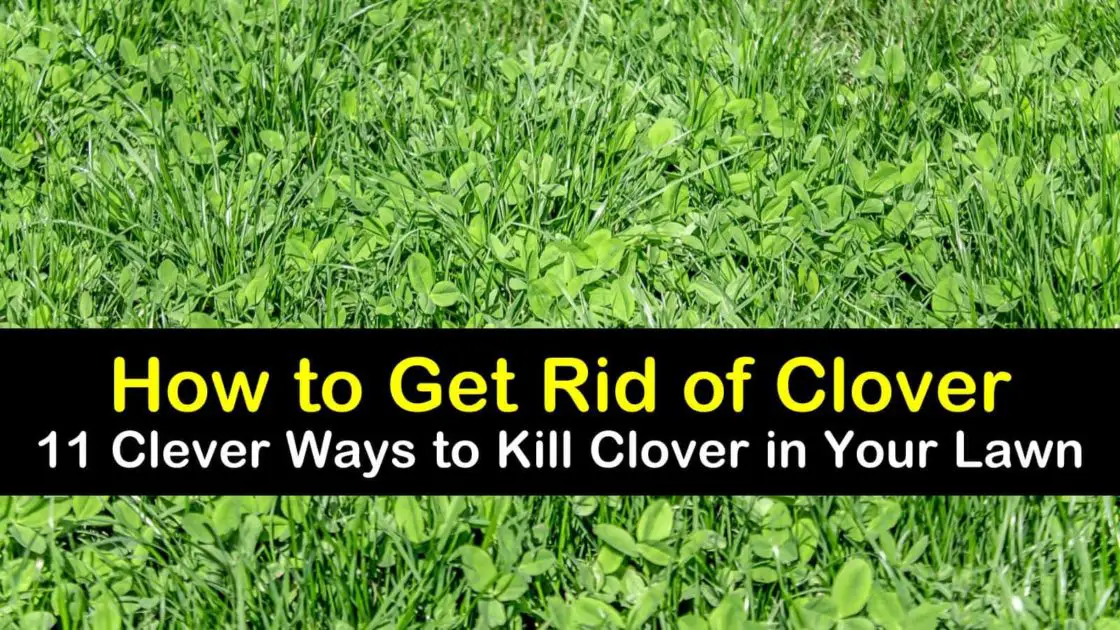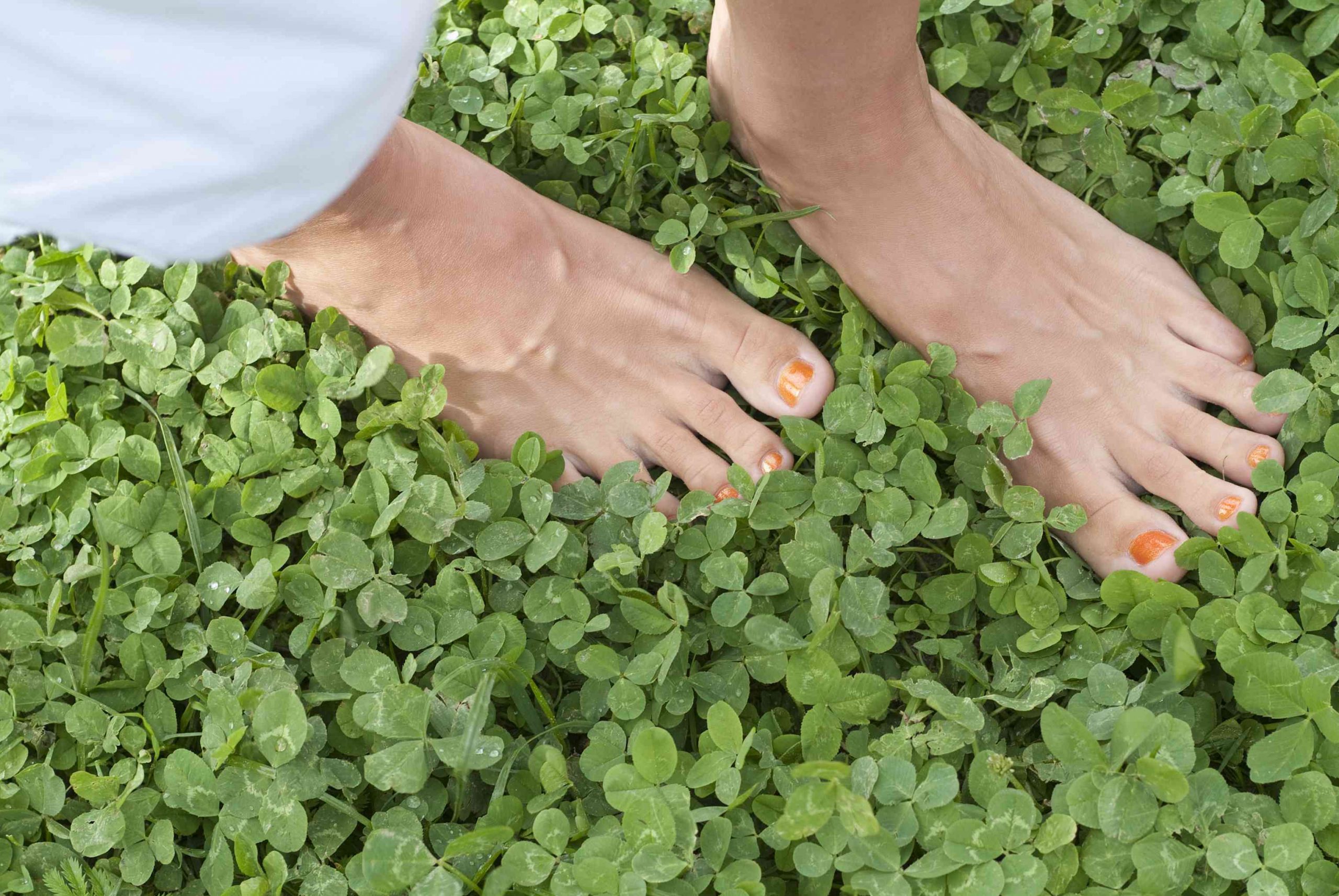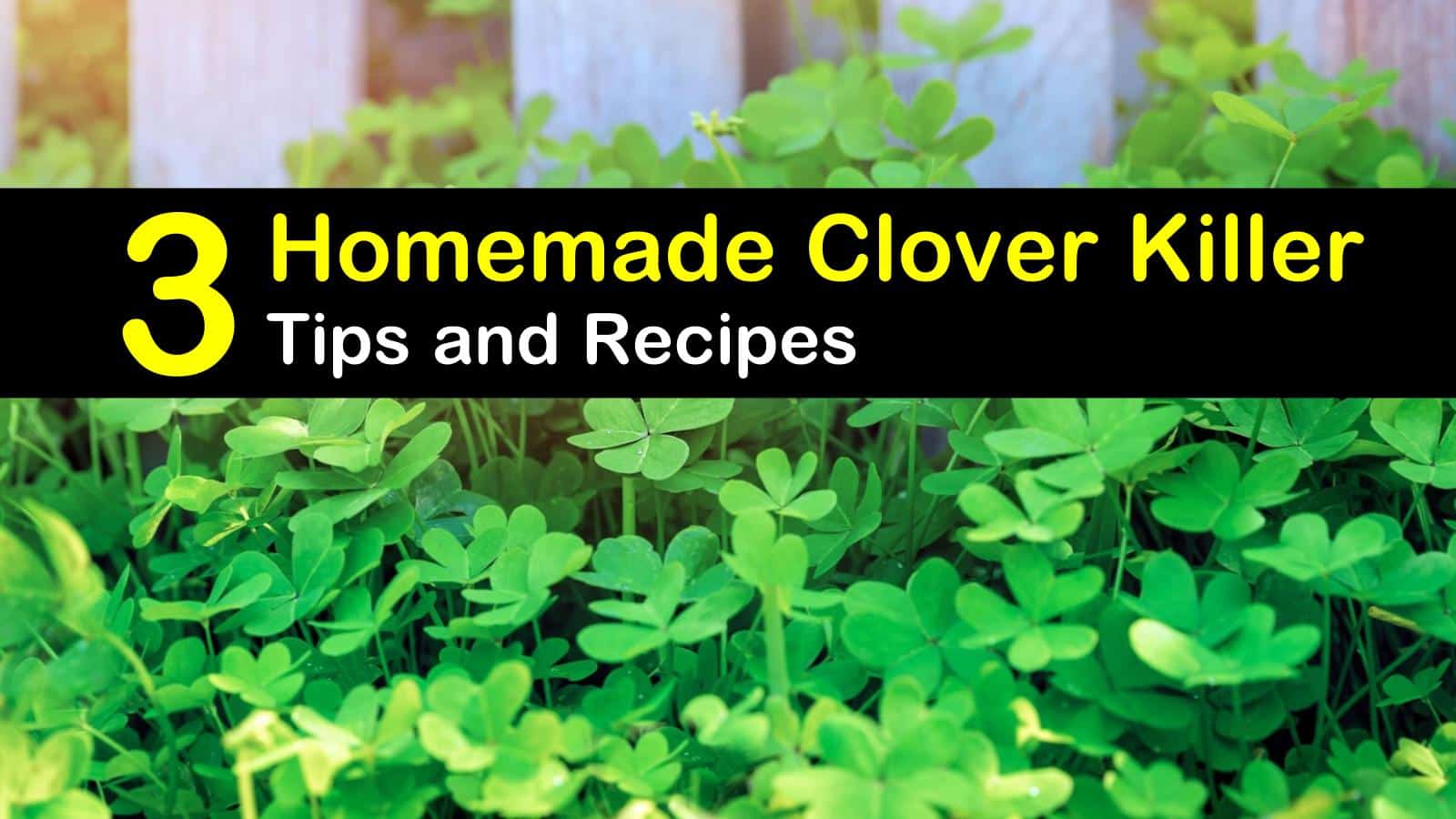How To Get Rid Of Clover In Your Lawn
Remove clover as soon as you see it. It can spread quickly by seed and creeping stems. If the amount of clover in your lawn is minimal, its best to remove it by hand. Loosen the soil to make it easier to remove the entire clover root. If theres more clover than is practical for hand removal, consider spot treating with an herbicide.
If you decide to treat the entire lawn, a broadleaf herbicide application in fall is very effective. Make sure the herbicide is safe to use on your variety/ies of grass, otherwise you may kill the grass along with the clover. Always follow manufacturer instructions and community regulations.
Make Your Own Clover Killer
Its easier than you may have thought to get rid of clover in flower beds or spots in your lawn. We have a variety of simple methods and homemade recipes that show you how to get rid of clover and prevent it from coming back.
Well show you how to make a natural acetic acid weed killer spray and how to perform weed control by maintaining a healthy lawn. Visit your pantry and the cabinet beneath the kitchen sink for the ingredients for this simple weed killer.
Block Oxygen & Sunlight
All plants, including clover, need oxygen and sunlight to survive and thrive. Depriving the clover of these resources by covering the patches with a garbage bag, plastic sheet, or small tarp will slowly kill the clover. Prolonged deprivation of these resources will also destroy most lawn grasses, so make sure to remove the cover after the clover has withered.
Also Check: Trugreen Cost Per Acre
How To Get Rid Of Clover In Your Lawn Naturally
If you dont want clover taking over your lawn, there are several natural and organic ways to get rid of itno harsh chemicals needed.
Some homeowners like clover in their lawn, but many dont. If white clover is springing up and creeping out in patches in your yard, there are several ways you can get rid of it. If youre interested in going green, theres good newsyou dont have to use harsh chemicals. There are a number of simple ways to get rid of clover in your lawn naturally.
This Old House has rounded up the best methods for getting rid of clover in your lawn naturally, some of which wont even harm your grass. Once youve eradicated your clover problem, The This Old House Reviews Team recommends hiring a professional lawn care company to keep your lawn healthy, hardy, and robustmuch less likely to attract clover. We recommend TruGreen, an industry leader that offers five annual programs and a la carte services.
Should I Get Rid Of Clover In My Lawn

There are several reasons you may want to keep clover in your lawn. Due to its symbiotic relationship with bacteria, clover acts as a natural fertilizer. Clover gets its nitrogen from the air and releases it into the soil. Another benefit? Clover outcompetes other weeds. So instead of something unwanted and unsightly, you could have clover.
Read Also: Does Lowes Rent Lawn Mowers
Can Clover Replace Turf
Throughout the article, I have introduced you to the clover properties and numerous ways to get rid of it. But, heres something completely different.
Did you know that you can actually create a clover lawn?
Inquiries on clover lawns are growing in popularity primarily because of the pollinator crisis. Both wild and domesticated bees are experiencing massive losses globally, partially due to the lack of food.
In that context, our turf lawns lack any flowers they can collect nectar from. To insect pollinators, our lush turf is just one big green desert.
Last but not least, we depend on pollinators for our survival they pollinate the crops we turn into food.
Because of that, some people have changed their lawn maintenance practices and turned to more natural, old-school lawn mixes that include low-growing flowering species.
Pollinators are not the sole reason, though. Some people have studied the properties of clover and decided that the fact that it doesnt require fertilization, doesnt need a lot of mowing and that it easily outcompetes other weeds will save them a lot of money and time.
Clover lawns consist of low-growing species of clover such as the White clover or Micro Clover . Micro clover doesnt flower much, so its a way to surpass bees if they present a hazard for you.
A clover lawn has some disadvantages too we have covered those in the Is it bad to have clover in your lawn section.
Why You May Want To Keep Clover In Your Lawn
You may not like the look of clover, but it can actually benefit your lawn.
- Natural Fertilizer: Clovers symbiotic relationship with beneficial bacteria allows it to absorb nitrogen from the atmosphere. Ultimately, it can make your lawn greener and more lush. However, this will keep it growing and outcompeting your grass.
- Weed Prevention: Mowing your lawn high will prevent weeds from growing, including clover. But if you like short, neat grass thats under 3 inches, letting clover flourish is a solid option. Clovers leaves cast shade over the soil, making it hard for other weeds to take root and grow and compete with your grass.
Recommended Reading: Houseplant Sticky Stakes Lowe’s
Getting Rid Of Clover In Your Lawn
October 25, 2018// by Scott Smith
White clover is a very easy weed to recognise, and you may have spent countless childhood hours hunting for the four-leaf version. While that can be a fun challenge, eradicating a clover infestation from your lawn is not.
A common weed in Australia, clover has the very recognisable three green serrated leaves topped by white, ball-shaped flowers and creeping stems. Clover is a legume plant that draws nitrogen from the air to store in its roots. It spreads easily throughout lawns via stems attached to the soil which grow into new plants. Clover is a winter-germinating weed, and will thrive and spread in spring when soil temperatures are mild and warm and plenty of sunlight reaches the soil surface.
Clover can often be quite difficult to get rid of, as it reseeds itself every year and will continue to come back. It spreads easily in a few different ways, and can even propagate from its own clippings.
Covering Clover With Plastic Sheets
Covering clover with a dark plastic sheet such as a garbage bag will deprive it of two key elements sunlight and oxygen. Additionally, if it is in a sunny position, the plastic will sort of steam-cook the plants beneath it.
The method is practical only for larger, homogenous clover patches, as all plants will be affected by covering, including the surrounding turf.
Recommended Reading: Will Peat Moss Help My Lawn
So Over Clover These Strategies Might Help
Al hacer clic en el enlace de traducción se activa un servicio de traducción gratuito para convertir la página al español. Al igual que con cualquier traducción por Internet, la conversión no es sensible al contexto y puede que no traduzca el texto en su significado original. NC State Extension no garantiza la exactitud del texto traducido. Por favor, tenga en cuenta que algunas aplicaciones y/o servicios pueden no funcionar como se espera cuando se traducen.
English is the controlling language of this page. To the extent there is any conflict between the English text and the translation, English controls.
Q: How do I control clover in my lawn?
A: Seems that we have had many more questions than normal on how to deal with clover in the lawn this year. Although, clover is a cool-season weed it has still been noticeable in the lawn well into summer.
Clover actually is a popular plant for cover crops in gardens and in erosion control, however it can be a challenge in the lawn because it has creeping stems that produce roots and shoots along the stem, helping the plant to take hold and spread.
Jessica Strickland
Donât Miss: Diy Yard Aerator
When The Natural Methods Fail Using Weed Killers For Clover
Now, we have covered how to get rid of clover in grass naturally. However, if all of these methods fail, you can resort to using commercial herbicides for broadleaf weeds. Those are the products that contain active compounds such as Dichlorophenoxyacetic acid, Mecoprop, and Dicamba.
These chemicals cause deformed growth in broadleaf weeds but do not damage the grass. However, they are far from benign substances through constant exposure and accumulation, they can harm other creatures, including humans.
That is why it is better to spot-treat the problematic weeds than to apply the herbicides broadly. Since they do nothing to prevent the weeds from sprouting, there is no point in doing so anyway.
Green tip: Avoid Weed and Feed products. As Weed-and-Feed is applied non-selectively and broadly, you will introduce much more toxic materials than necessary. That can have a myriad of negative impacts on the environment, the wildlife, and eventually your health.
Recommended Reading: How To Get Rid Of A Broken Lawn Mower
Why Do I Have So Much Clover In My Lawn
According to Todays Homeowner with Danny Lipford, clover is a sign that your lawn needs more nitrogen. Clover can thrive in nitrogen-poor soil because it absorbs nitrogen from the air. You can increase soil nitrogen with aeration, a top-dressing of compost, an organic, slow-release fertilizer, and by not overwatering.
How To Get Rid Of White Clover Without Destroying The Lawn

To get rid of white clover in your lawn you can try 2 methods.
- To pull out the weed manually by hand
- To apply a selective herbicide to your lawn which only kills white clover weed in your lawn and doesnt harm the grass.
Lets discuss how to do these properly in detail:
1.Pull it out
The best way to get rid of a small amount of clover weed in your lawn is to pull it out by hand. First water your lawn to make the soil moist so that you can remove the weed very easily without leaving any roots in the soil. This will ensure that you have eliminated all the weed and it will not come back.
2.Apply herbicide
The second way to remove clover from your lawn is to apply selective herbicide which only kills clover weed and doesnt affect your grass. Apply herbicide when the soil is moist and do a little watering after the application of the herbicide to wash away all the herbicide from the leaves of the grass so it doesnt get burned.
You May Like: Scotts Summerguard Burned Lawn
Use Corn Gluten On Clover
Another way to get rid of clover is to use corn gluten. Corn meal gluten kills off the clover without harming nearby plants. It works by releasing organic dipeptides into the soil. The dipedtides dry out the clovers seeds and make it hard for them to sprout. This well-reviewed product can be used by mixing three parts water to one part corn gluten. One liter of this mixture will cover about 1,000 square feet. Once applied, be sure to water well and then allow it to dry.
Note: While the dipedtides have worked to get rid of clover for some, corn gluten hasnt worked for all, and is therefore not universally regarded as a solution for dealing with clover.
Step #1 Get The Right Products And Tools
Clover is easily damaged by many herbicides but its aggressive growth habit can often allow it to recover and return to the lawn. Eradicating it requires choosing the correct herbicide and applying it precisely. For cool season lawns, the best herbicide to use on clover is triclopyr. Triclopyr can be found as a standalone product or in blends where it is combined with other herbicides. I prefer blends as they fight dozens, if not hundreds of weeds with multiple modes of action. My favorite triclopy-containing four way is T-Zone, a devastating product that makes quick work of clover and other broadleaf weeds.
Why DoMyOwn?DoMyOwn.com offers professional-grade insecticides to DIYers while ensuring proper storage of chemicals. Couple that with their impressive customer service and knowledgeable staff, its the #1 choice.
However, there are situations where using T-Zone or other blends is not advised, most particularly in lawns with exposed tree roots. Most blends including T-Zone contain the herbicide Dicamba which can be absorbed by exposed roots and cause severe damage to the trees that have produced them. In cool season lawns with exposed roots, it makes sense to use triclopyr as a standalone product this one from Hi-Yield is excellent or combined in a homemade blend with Tenacity.
To summarize
| Dismiss Turf Herbicide |
Read Also: How To Get Rid Of Purple Violets In Lawn
Smother The Entire Lawn And Start Over Again
If you have a smaller lawn, and its completely overrun with clover, moss, and weeds, you may be tempted to start over again.
To do this, its best to avoid using herbicides to kill everything on your lawn, as this can ruin the fertility of the soil. Instead, smother your grass using a large tarpaulin, and then reseed it, or lay new sod.
You will need to wait about three weeks for everything on your lawn to die, and decompose enough to plant new grass.
You Should Smother It
Clover can survive just fine when grown away from other plants, particularly large grasses like the common lawn variety.
Lawn turfgrass will die if you try to smother it with a plastic sheet, but in most cases, it grows back quickly and is little more than a minor inconvenience.
Clover planted near trees or shrubs will also grow even outside of the typical lawn environment as long as growing conditions are good and too much moisture isnt present because clover does not tolerate waterlogged soils.
Also Check: How To Clean Toro Lawn Mower
Planting And Maintaining A Clover Lawn
- Clover lawns can be established by encouraging already-existing clover patches in your landscape, by seeding, or a combination of both.
- It is best seeded in early spring from mid-March to mid-April. It can also be seeded in fall. Tiny clover seeds are difficult to sow evenlyone way to improve your chances is to mix the seed in with some soil, sawdust, or sand. If you donât have any in your lawn or nearby, you may need to add a bacterial inoculant to promote the best growth if you do already have it in your lawn, however, the inoculant is probably already present in the soil.
- After planting, use a misting attachment to water daily until you can see the seedlings.
- Existing clover patches can be encouraged by mowing with the blades set at 1.52 inches, which favors clover over most traditional turf grasses.
- In the middle of summer, stop mowing to encourage clover to flower and seed.
- Once established, most clovers are low-growing and require little or no mowing, unless you wish to discourage bees by mowing to prevent summer blooms.
- Never apply herbicides to a clover lawn.
- It is a short-lived perennial and may require reseeding approximately once every three years to maintain consistent coverage. It may successfully reseed naturally, however, or wild clovers may move in and take over aging stands.
Corn Gluten Meal Kills Clover
You can purchase corn meal gluten at your local garden centers or online. Kill grass and weeds naturally with this simple staple. The benefit of this method is that it doesnt affect any other plants growth, aside from the clover and weeds you want to eliminate.
How corn meal gluten works to inhibit clover is through dipeptides, which are released into the soil and dry out clover and other weed seeds. Dry seeds have a difficult time sprouting.
Use about 20 pounds of product for every 1,000 square feet of grass. After applying corn gluten, water thoroughly and allow to dry.
You May Like: Will Vinegar Kill Dallisgrass
Deprive Clover Of Sunlight
If youve been wondering how to get rid of clover, weve got you covered. If youre dealing with a large clover patch and youre willing to sacrifice your grass, place plastic sheeting, or a large garbage bag, over the clover. Be sure to secure the perimeter so the plastic doesnt fly off. Keep the clover covered for a few weeks. Depriving it of sunlight and oxygen should do the trick will kill it .
To start over with new grass, first youll have to determine if you want to use seed or sod. This discussion will help.
How Do I Identify Clovers In My Yard

Clover is a legume that made its way to North America in the latter part of the 17th century, and its origins can be traced back to Europe. Edenapp brings the three most common types of clover and their distinguishing characteristics to help you identify them.
- White clover : White clover is the most common clover species found in lawns. It is a perennial, low growing and hardy clover species that spreads really quickly through stolons. You can identify it by its distinguishing characteristics, which are the florets that grow on its ends in shades of white and pink.
- Red clover : Red clover can thrive in both dry or moist conditions. This type is bushier and taller than white clover, and you can identify rec clover by the florets, whose color ranges from red to magenta. Red clover is also called meadow clover, wild clover and cow clover.
- Strawberry clover : The growing patterns of strawberry clover are similar to white clover, the difference being that strawberry clover can thrive in coastal areas or near river estuaries as it has a higher salinity tolerance. You can identify strawberry clover by its pink and white florets that are smaller than those of white clover.
Don’t Miss: How To Fix Lawn Depressions
